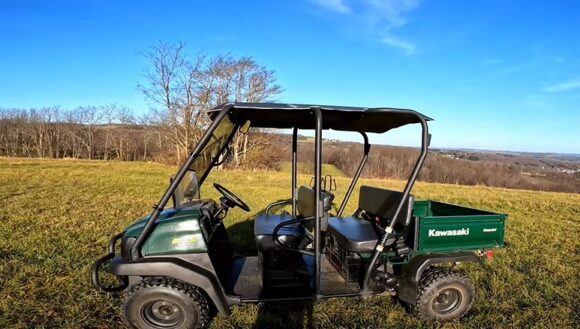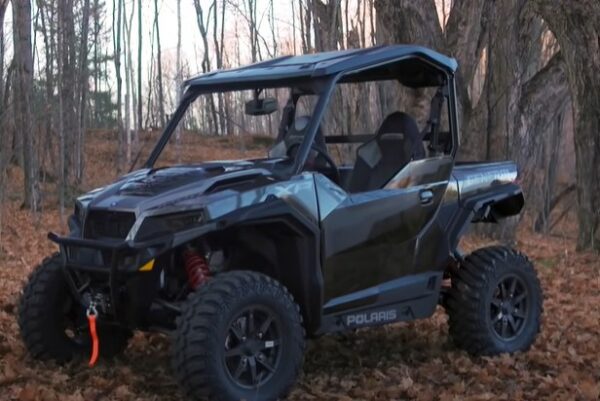The Kawasaki Mule 3010 is a well-known and reliable utility vehicle that has been used in various industries for decades. However, like any other machine, it is not without its problems.
In this comprehensive guide, we will explore the most common issues that owners may encounter with the Kawasaki Mule 3010 and provide insights on how to address them effectively.
Kawasaki Mule 3010 Problems

1. Overheating Issues
One of the primary problems that Kawasaki Mule 3010 owners may face is overheating.
This can be caused by a variety of factors such as improper air/fuel mixture, high compression, dirty radiators, dragging brakes, poor lubrication, torque converter engagement, and cooling system issues.
If left unresolved, overheating can lead to reduced engine performance, excessive fuel consumption, and limited acceleration.
To address overheating problems, it is essential to take the following steps:
- Clean the engine: Over time, dirt and debris can accumulate on the engine, impeding proper airflow and causing overheating. Use a soft bristle brush to clean the motor thoroughly, ensuring that all areas are free from dirt and grime.
- Check the oil level: It is crucial to maintain the oil level within the recommended range. Verify that the oil tank is neither overfilled nor empty. Wait until the engine cools down before adding or changing the oil.
- Inspect the fuel filter and hose: Ensure that the fuel filter and hose are in good condition. Any clogs or damage can restrict the fuel flow and contribute to overheating. Replace them if necessary.
- Monitor the cooling system: Regularly check the cooling system components, including the radiator and coolant. Clean or repair any clogged or damaged parts to ensure proper heat dissipation.
2. Drivetrain Noise
Another common problem reported by Kawasaki Mule 3010 owners is drivetrain noise.
This can manifest as unusual sounds during operation and may indicate issues with the transmission, suspension, or drive pulley components.
- Inspect the drive pulley sheaves: Worn or loose drive pulley sheaves can contribute to drivetrain noise. Check for signs of damage and replace any components that show excessive wear.
- Check the LSD clutch friction plate and spring: If the drivetrain noise persists, consider inspecting the LSD clutch friction plate and spring. Damage or wear in these components can cause unwanted noise and should be addressed promptly.
- Examine the universal joint: A dented universal joint can also contribute to drivetrain noise. Carefully inspect the joint and replace it if necessary.
- Inspect the transmission gears: Chipped or damaged transmission gears can cause abnormal noise during operation. If gear-related issues are suspected, consult a professional for further inspection and potential repairs.
3. Brake Problems
Problems with the brakes can be a safety concern and should be addressed promptly.
Some Kawasaki Mule 3010 owners have reported issues with the brake system, such as erratic lights, poor braking performance, and the need for excessive pressure on the brakes to stop the vehicle.
- Check for corrosion and low voltage: Corrosion or low voltage can affect the proper functioning of the brake system. Inspect the brake components for any signs of corrosion and ensure that the voltage is within the recommended range.
- Inspect the brake wires: Loose or cut brake wires can compromise the effectiveness of the brakes. Carefully examine the wires and repair or replace them as needed.
- Maintain proper brake fluid levels: Check the brake fluid levels and ensure they are within the recommended range. Top up or replace the fluid if necessary, following the manufacturer’s guidelines.
4. Transmission Problems
Transmission problems can greatly impact the performance and functionality of the Kawasaki Mule 3010.
Some owners have reported difficulties when shifting gears or complete transmission failure, resulting in issues with starting, ignition, and operation.
- Check for cold weather issues: In cold conditions, transmission problems may arise. Ensure that the vehicle is stored in a warmer location to prevent cold-related transmission issues.
- Use the correct transmission oil: It is essential to use the recommended transmission oil for your Kawasaki Mule 3010. Avoid using any other type of oil that may not be suitable for the transmission system.
- Inspect the CVT belt: The CVT belt plays a crucial role in the transmission system. If there are signs of wear or damage, replace the belt with a new one to restore proper transmission functionality.
- Consult a professional for further inspection: If the transmission problems persist or are more complex, it is advisable to consult a professional mechanic who specializes in Kawasaki Mule 3010 vehicles. They can provide a more in-depth inspection and recommend appropriate repairs or replacements.
5. Battery Issues
Battery issues can cause starting and operation problems with the Kawasaki Mule 3010. Some owners have reported difficulties starting the vehicle, even with a fully charged battery.
This can be frustrating and affect the overall usability of the utility vehicle.
- Check the battery voltage: Use a voltmeter to measure the battery voltage and ensure that it is within the recommended range. If the battery is not holding a charge, it may need to be replaced.
- Inspect the carbon connector: The carbon connector, which connects the battery to the electrical system, can become hardened over time. Clean the carbon connector to ensure proper electrical connection.
- Verify proper charging system: If the battery is not charging, there may be an issue with the charging system. Consult a professional mechanic to diagnose and repair any charging system problems.
6. Starting Problems
Difficulty starting the Kawasaki Mule 3010 is another issue reported by some owners.
This can be frustrating and may indicate underlying issues with the ignition system, fuel delivery, or other components.
To troubleshoot starting problems, you should check for these things:
- Inspect the spark plugs: Worn or faulty spark plugs can affect the ignition system and make starting difficult. Replace the spark plugs if necessary.
- Check the fuel delivery system: Ensure that the fuel pump is functioning properly and delivering fuel to the engine. If there are issues with fuel delivery, consult a professional for further inspection and potential repairs.
- Examine the carburetor: The carburetor plays a crucial role in fuel mixture and delivery. Clean or repair any clogged or damaged parts to ensure proper fuel flow.
- Verify the ignition timing: Incorrect ignition timing can make starting problematic. Adjust the ignition timing if adjustable or consult a professional for assistance.
7. Tire Problems
Tire issues can affect the performance and safety of the Kawasaki Mule 3010. Some owners have reported problems with tire wear, punctures, and insufficient traction.
Proper tire maintenance is crucial to prevent these issues and ensure optimal performance.
To maintain your tires and fix problems, try the following steps:
- Regularly check tire pressure: Proper tire pressure is essential for optimal traction and performance. Check the tire pressure regularly and adjust as needed to meet the manufacturer’s recommendations.
- Inspect tires for wear and damage: Regularly examine the tires for signs of wear, such as cracks or flat spots. Replace any tires that show excessive wear or damage to ensure safe operation.
- Use appropriate tires for the terrain: Different terrains require different tire types. Ensure that you are using tires suitable for the conditions in which you will be operating your Kawasaki Mule 3010.
8. Accelerator Problems
Problems with the accelerator can greatly impact the performance and responsiveness of the Kawasaki Mule 3010.
Some owners have reported issues with sluggish acceleration and stumbling when the throttle is opened.
To troubleshoot accelerator problems, try these steps:
- Check for fuel-related issues: Verify that the fuel system is functioning properly, and there are no clogs or restrictions in the fuel lines or filters. Ensure that the fuel pump is delivering adequate pressure and flow.
- Inspect the carburetor: Clean the carburetor thoroughly, paying attention to any clogged passages or jets. Ensure that the carburetor is adjusted correctly for proper fuel mixture and delivery.
- Examine the ignition components: Faulty ignition components can affect engine performance and acceleration. Inspect the spark plugs, ignition coil, and other ignition system parts for any signs of wear or damage. Replace or repair as necessary.
- Consider re-jetting the carburetor: Some owners have reported improvements in acceleration by re-jetting the carburetor. Consult a professional or refer to the manufacturer’s guidelines for proper jet sizing and installation.
9. Headlight Problems
Headlight problems can affect visibility and safety during nighttime or low-light conditions.
Some Kawasaki Mule 3010 owners have reported issues with the headlights not functioning correctly or providing insufficient illumination.
To fix this problem follow these steps:
- Check the bulbs: Ensure that the headlight bulbs are in good condition and properly seated in their sockets. Replace any bulbs that are burnt out or damaged.
- Inspect the wiring: Check the wiring connections for any loose or damaged wires. Repair or replace any faulty wiring to restore proper headlight functionality.
- Verify the voltage: Measure the voltage at the headlight socket to ensure that it is within the recommended range. Low voltage can affect the brightness of the headlights.
- Consider upgrading to LED headlights: LED headlights offer improved brightness and energy efficiency compared to traditional halogen bulbs. Consider upgrading to LED headlights for enhanced visibility.
10. Power Loss
Power loss over time can be a frustrating issue for Kawasaki Mule 3010 owners. This can manifest as reduced acceleration, sluggish performance, and overall diminished power output.
To fix power loss problems, consider the following steps:
- Check for fuel system issues: Ensure that the fuel system is clean and free from clogs or restrictions. Verify that the fuel pump is delivering adequate pressure and flow to the engine.
- Inspect the air filter: A clogged or dirty air filter can restrict airflow to the engine, resulting in power loss. Clean or replace the air filter as needed to ensure proper engine performance.
- Examine the exhaust system: A restricted or damaged exhaust system can impede the flow of exhaust gases and reduce power output. Inspect the exhaust system for any leaks, clogs, or damage. Repair or replace components as necessary.
- Verify proper ignition timing: Incorrect ignition timing can result in poor combustion and reduced power. Adjust the ignition timing if adjustable or consult a professional for assistance.
Technical Specifications of Kawasaki Mule 3010:
| Technical Specifications | Details |
|---|---|
| Engine | 617 cc, 4-stroke, V-twin |
| Power | Approximately 20 HP |
| Transmission | Continuously Variable Transmission (CVT) with High/Low range and reverse |
| Drivetrain | 2WD/4WD selectable |
| Suspension Front | Independent MacPherson strut |
| Suspension Rear | Semi-independent, De Dion axle |
| Towing Capacity | Up to 1,200 lbs (depending on model) |
| Cargo Bed Capacity | Up to 800 lbs (depending on model) |
| Fuel Capacity | 6.4 gallons |
| Length | 116.3 inches |
| Width | 58.5 inches |
| Height | 75.8 inches |
| Ground Clearance | 7.3 inches |
| Wheelbase | 73.6 inches |
| Brakes | Hydraulic drums or discs (front/rear) |
| Seating Capacity | Up to 2 passengers |
Pros and Cons of Kawasaki Mule 3010:
Pros:
- Durability and Reliability: The Mule 3010 is known for its rugged construction and longevity. Many users have reported that the vehicle can take quite a beating and still function effectively.
- Versatility: This utility vehicle can be used for a variety of tasks, from farming and ranching tasks to recreational trail riding.
- Carrying Capacity: The Mule 3010 has a sizable bed that can carry equipment, materials, or even a small group of people.
- Selectable Drive Mode: Users can switch between 2-wheel and 4-wheel drive, allowing for flexibility in various terrains.
- Good Towing Capacity: Useful for hauling trailers or other equipment around farms, ranches, or worksites.
Cons:
- Speed: The Mule 3010 isn’t designed for speed. While it’s great for work-related tasks, it might not be the best choice for those looking for a fast recreational ride.
- Lacks Some Modern Features: Compared to newer models or other brands, the 3010 can lack certain modern features, like advanced suspension systems or digital displays.
- Fuel Efficiency: Some users report that the Mule 3010 isn’t the most fuel-efficient utility vehicle on the market.
- Noise Level: It can be noisier than some of its competitors, which might be a concern in certain environments or for prolonged usage.
Conclusion
The Kawasaki Mule 3010 is a reliable and versatile utility vehicle. However, as with any machine, it is not immune to problems.
By being aware of the common issues that owners may encounter and following the troubleshooting steps provided, you can effectively address these problems and ensure the continued performance and longevity of your Kawasaki Mule 3010.
Arctic Cat Prowler 1000 Problems


